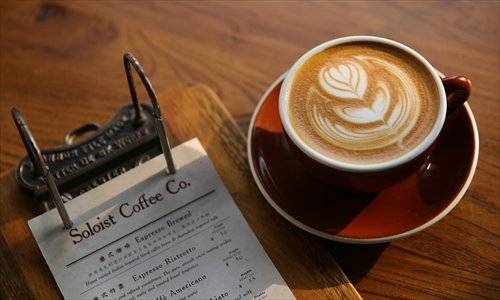HOME >> LIFE
Fresh coffee
Source:Xinhua Published: 2014-2-10 21:03:01

Speciality coffee means more choice for Chinese customers. Photo: Courtesy of Guo Hang
While steamed bun manufacturer Goubuli is reportedly in talks to buy out a US coffee chain to promote Chinese cuisine overseas, increasingly international Beijing has had its own upsurge in cultural imports, with a glut of Western-style shops, bars, cafés and restaurants popping up in the capital.They've always been around, but in just a few short years, the range, quantity and quality of these outlets has shot up.
Ma Kaimin, also known as Phil Ma, is one of those feeding this appetite for the new. He is the owner of Soloist Coffee Co. in Qianmen, running a café down a hutong not far from the famous Dashilar shopping street.
While his shop sits squarely in a chunk of old Beijing - the hutong just one of a throng of tiny alleyways with roots in the Qing Dynasty(1644-1911) and a short walk from Tiananmen Square - inside the decor wouldn't look out of place in London or New York.
Mismatched furniture, exposed brickwork and bare filament bulbs found in any number of Western hipster bars are in abundance. No effort is made to conceal the pipes and cables powering the many machines and antique advertising posters adorn the walls, alongside a bicycle fixed somewhere near head height.
The specialty coffee is clearly a far cry from the ever-popular Nescafé 1+2 sachets and the ubiquitous Starbucks. Here, Ma sets up a stand looking suspiciously like a chemistry set to slowly filter the coffee into a glass jug, and the default serving is black to ensure the customer tastes the complex flavors of the beans sourced by a specialist dealer.
He politely advises not confusing the palate with a snack before tasting, and explains the beverage is at its best before it drops to room temperature.
He was trained in South Korea and has professional accreditation from the Specialty Coffee Association of America (SCAA), becoming a "licensed Q grader." They roast the green beans in-store. In other words, he takes his caffeine very seriously.
Ma, 35, is also a photographer and draws comparisons between the two passions, explaining that the need for technical know-how goes hand-in-hand with creativity, though he says coffee also makes him feel "connected to nature."
"In photography, you need to practise certain required skills and buy appropriate equipment, but people have different approaches. The coffee is just like that."
"Also, the photographer has to have a good eye, to know the different effects of different light and so on. With coffee, you have to develop a good palate to tell the difference between different beans."
His attention to detail stretches to the decor, the carefully handpicked antique furniture and very particular industrial look. "The environment and coffee have something in common: craftsmanship. The style is 1930s, the age of industry. In that era, people put equal emphasis on industrialization and craftsmanship."
Choosing a time of huge development as inspiration is apt, however while he acknowledges the style as Western, he is polite but firm that he is not trying to ape Western culture or solely attract foreign tourists and ex-pats, and is reluctant to agree that the growing popularity of coffee shops in China could be down to Western influence.
"To some extent," he says. "But looking at the whole history of coffee, in Western countries coffee is also a relatively new thing. Coffee shops like us are few in China, but I think will gradually become more widespread."
"The SCAA is an American system, but it's like a third wave - globally, it' s a new thing. The environment and decoration here - if you want to say it was influenced by the Western world, I can admit that. But I prefer to say that it's an international thing because this coffee revolution has just started and it's worldwide."
"The foreigners who come here also find it amazing! It's new for everyone."
Some big international brands coming into China have met with problems - Starbucks recently came under fire for allegedly charging Chinese consumers a premium to enjoy a product the rest of the world had been sipping cheaper.
But shops like Ma's are part of a cultural interaction rather than a wholesale import, and the fact it's down a hutong and not in one of the shiny new shopping malls speaks to that.
Four months ago, a government enterprise asked him to move from the art district, where he'd been for over a year, to Qianmen. While there's undeniably been some conflict between the rapid modernization of Beijing and the preservation of its more traditional areas, especially with many completely demolished to make way for high rises, Ma says development and heritage don't have to be mutually exclusive.
"The government wants to develop this area and thought my shop was unique and wonderful," he explains. "I was happy to move because we can have a long-term lease here and plan for the business' future."
"Redevelopment like this is better than everything being knocked down. It keeps the vitality of the area."
Ma says the space now occupied by the coffee shop has been variously a printing house, a public bathroom and a jewelry shop, among other things, his business just the most recent in a long line of reinvention.
Parts of Qianmen have been redeveloped beyond recognition, while others retain their original character. In an area where vast extremes of Beijing's history and big international brands sit next door to each other, perhaps places like Ma's coffee shop sit in the middle - an example of the city opening up to international tastes and introducing new experiences.
For his part, Ma Kaimin is clear on his personal hopes and motivations. "When someone comes in, first of all we have to get them a good coffee. We hope this environment will encourage people, give them a totally different environment from their regular life."
Posted in: Food